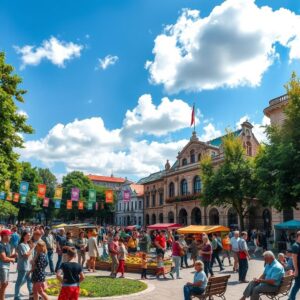
Explore & Play
Discover interesting topics and solve the accompanying crossword puzzle.
Canal crossword | World’s Historic Waterways
Table of Contents
Canal Crossword
You can either fill in the crossword puzzle directly on this page or click the button in the bottom right corner to print it for free.

Navigating the World's Most Historic Waterways: From Suez to Panama
Canals have long been the lifeblood of global trade, cultural exchange, and urban development, creating connections that span continents and centuries. From ancient waterways that supported the growth of empires to modern marvels that facilitate global commerce, canals have been essential in shaping the world as we know it today. In this article, we’ll explore some of the world’s most significant canals, from the famous Suez and Panama to lesser-known but equally fascinating waterways. And, for those eager to test their knowledge, a crossword challenge awaits!
1. The Giants of Global Trade: Suez and Panama
At the heart of the world’s maritime trade routes lie two of the most crucial canals: Suez and Panama. These waterways have redefined global commerce and remain indispensable to international shipping.
Suez Canal: Gateway Between East and West
The Suez Canal, which connects the Mediterranean Sea to the Red Sea, is one of the most significant man-made waterways in the world. Opened in 1869, this canal drastically reduced travel time between Europe and Asia, eliminating the need to navigate around Africa’s Cape of Good Hope. Today, nearly 12% of global trade passes through the Suez Canal, making it a vital artery for oil, gas, and consumer goods.
Panama Canal: Linking the Atlantic and the Pacific
Similarly, the Panama Canal, completed in 1914, transformed global maritime routes by linking the Atlantic and Pacific Oceans. This engineering marvel cuts through the Isthmus of Panama, providing a much shorter route for ships traveling between the two oceans. Recently expanded to accommodate larger vessels, the canal continues to be a pivotal passageway in global trade, moving billions of dollars of cargo annually.
2. European Waterways: From Scenic Routes to Commercial Arteries
Europe’s vast network of canals offers a tapestry of history, culture, and engineering marvels. These waterways are not only scenic routes for tourists but also serve as commercial arteries that support local economies.
Canal du Midi: A French UNESCO Heritage Site
The Canal du Midi in France, completed in 1681, is a masterpiece of engineering and a UNESCO World Heritage site. Stretching from Toulouse to the Mediterranean Sea, this canal was initially built to transport goods such as wine, wheat, and textiles. Today, it is celebrated for its picturesque views, lined with plane trees and dotted with charming villages.
Kiel Canal: Germany’s Maritime Shortcut
The Kiel Canal, located in Schleswig-Holstein, Germany, is one of the busiest artificial waterways in the world. It connects the North Sea with the Baltic Sea, providing a shortcut that saves ships the long journey around Denmark’s Jutland Peninsula. This canal is crucial for both commercial shipping and military operations, significantly reducing travel time and costs.
Amsterdam Canals: The Venice of the North
Amsterdam’s canals are iconic, weaving through the city in a pattern that has earned it the nickname “Venice of the North.” Constructed during the Dutch Golden Age in the 17th century, the canals were used to transport goods and manage water levels. Today, they are a UNESCO World Heritage site, attracting millions of visitors who admire the unique architecture and lively atmosphere along the waterways.
Bourgogne, Briare, and Centre Canals: Connecting French Regions
These French canals—Bourgogne, Briare, and Centre—form an intricate network linking major rivers like the Loire, Seine, and Rhône. Historically used for transporting agricultural goods, these canals now offer leisurely cruises, allowing travelers to explore France’s rich cultural and culinary heritage.
3. The Grand Canals: Exploring Asia’s Historic Waterways
Asia is home to some of the oldest and longest canals, which have served as vital lifelines for civilizations. These waterways have played crucial roles in fostering economic growth, cultural exchange, and regional integration.
Grand Canal (China): The World’s Longest Artificial Waterway
The Grand Canal in China, stretching over 1,100 miles, is the longest artificial waterway in the world. Dating back to the 5th century BC, it was instrumental in connecting the north and south of China, promoting trade, and facilitating the movement of goods, people, and ideas. This canal remains an essential part of China’s water transport system and continues to be a symbol of Chinese engineering prowess.
Chizhou: A Hub of Ancient Trade
Chizhou, located along the Yangtze River, is an ancient city with a network of canals that have supported local trade for centuries. These canals have been vital for transporting agricultural products and building materials, contributing to the region’s development and prosperity.
4. Waterways That Built Cities: The Role of Urban Canals
Many of the world’s greatest cities were shaped by their canals, which have influenced their growth and character. These urban waterways serve as vital links, promoting commerce and cultural exchange.
Paris Canals: Saint-Martin, Ourcq, and Saint-Denis
The canals of Paris—Saint-Martin, Ourcq, and Saint-Denis—are more than just picturesque waterways; they are a testament to the city’s industrial heritage. Constructed in the 19th century to transport goods and provide fresh water, these canals are now popular for leisure activities and urban exploration.
Venice’s Grand Canal (Italy): The Arterial Waterway of Venice
Venice’s Grand Canal, often referred to as “the most beautiful street in the world,” is the main waterway that cuts through the heart of the city. Lined with Renaissance palaces and bustling with gondolas and vaporettos, this canal has been central to Venice’s identity and economy for centuries.
Caen: France’s Forgotten Canal City
Caen, a city in Normandy, boasts a canal that links it to the English Channel. Though less famous than Paris or Venice, Caen’s canal has played a critical role in its history, particularly during World War II, serving as a strategic route for Allied forces.
5. Scotland’s Scenic Marvel: The Caledonian Waterway
Cutting through the rugged beauty of the Scottish Highlands, the Caledonian waterway offers a unique blend of natural and man-made wonders. Built in the early 19th century, this canal stretches from the east coast of Scotland to the west, connecting a series of lakes known as lochs. Today, it is a popular route for boating enthusiasts, offering breathtaking views of mountains, forests, and castles along the way.
6. The Americas: Beyond Panama – Exploring North America’s Historic Canals
While Panama may be the most famous, North America boasts its own rich history of canals that have shaped its development. These canals were crucial in opening new territories and linking distant regions.
Erie Canal: The Pathway to America’s Westward Expansion
The Erie Canal, completed in 1825, was a game-changer for the United States. By connecting the Hudson River to the Great Lakes, it facilitated the movement of goods and people, fueling the country’s westward expansion and economic growth. The canal’s construction was a remarkable feat of engineering, cutting through rugged terrain and over natural obstacles.
Rideau Canal: Canada’s Iconic Waterway
The Rideau Canal in Canada, a UNESCO World Heritage site, was built in the early 19th century as a military precaution against potential American invasions. Today, it is celebrated as one of the most scenic and historic waterways in North America, attracting visitors for boating, skating, and sightseeing.
Cape Cod Canal: New England’s Shortcut
The Cape Cod Canal, located in Massachusetts, connects Cape Cod Bay to Buzzards Bay. Built in the early 20th century, it was designed to provide a safer and shorter route for ships navigating around the treacherous waters of Cape Cod.
7. Forgotten Waterways: Lesser-Known but Fascinating Canals
Beyond the famous names, many lesser-known canals have stories that deserve to be told. These waterways have played vital roles in regional development and continue to be of local importance.
Welland Canal: A Crucial Link in the St. Lawrence Seaway
The Welland Canal, part of the St. Lawrence Seaway, connects Lake Ontario to Lake Erie, allowing ships to bypass Niagara Falls. This canal is essential for shipping goods between the Great Lakes and the Atlantic Ocean, supporting regional economies across North America.
Nantes à Brest Canal, Marne au Rhin, and Saône au Rhin: France’s Hidden Gems
These French canals may not be as famous as the Canal du Midi, but they are vital for connecting various regions and rivers. The Nantes à Brest Canal crosses Brittany, the Marne au Rhin Canal links Paris to the Rhine, and the Saône au Rhin Canal connects the Saône and Rhine rivers. Each has its own unique charm and historical significance, from transporting goods to offering picturesque routes for boating.
8. The Modern Age of Canals: Enhancements and Expansions
In the 21st century, many historic canals have seen modern enhancements to keep up with global demands. These upgrades ensure that these waterways remain relevant in a rapidly changing world.
Panama Expansion: A New Era for Global Trade
The recent expansion of the Panama Canal, completed in 2016, has allowed it to accommodate the largest cargo ships, known as “New Panamax” vessels. This expansion has strengthened the canal’s position as a key global shipping route, reducing transit times and costs.
Tancarville and Roubaix Canals: Revitalizing French Waterways
The Tancarville Canal, which connects the Seine to the port of Le Havre, has been upgraded to handle larger ships, enhancing its role in French maritime trade. Similarly, the Roubaix Canal in northern France has seen efforts to revitalize it for recreational use, reflecting a broader trend of repurposing historic waterways for modern needs.
9. The Future of Canals: Sustaining Global Connections
As the world becomes more interconnected, the importance of canals will only grow. Advances in technology and engineering will enable further enhancements, ensuring that these historic waterways continue to facilitate global trade and cultural exchange. However, there is also a need to balance development with sustainability, preserving these canals’ rich histories while preparing them for the future.
A Call to Action: Test Your Knowledge!
Ready to explore more about the fascinating world of canals? Challenge yourself with our “Canal Crossword” and see how much you remember! Whether you’re a history buff or just enjoy a good puzzle, it’s a great way to dive deeper into the waterways that have shaped our world.
Share to...
I hope you enjoy the content.
Want to receive our daily crossword puzzle or article? Subscribe!
You may also be interested in
Share to…
Want to receive our daily crossword puzzle?
-
Jigsaw Puzzles
Majestic Unicorn Watercolor Puzzle 250 | 300 | 500 Brikker
kr 348,00 – kr 439,00Price range: kr 348,00 through kr 439,00 Select options This product has multiple variants. The options may be chosen on the product page -
Jigsaw Puzzles
Chinese Zodiac Serpent Watercolor Jigsaw Puzzle 250 | 300 | 500 Pieces
kr 348,00 – kr 439,00Price range: kr 348,00 through kr 439,00 Select options This product has multiple variants. The options may be chosen on the product page -
Jigsaw Puzzles
Autumn Whiskers and Pumpkin Paws Puzzle 250 | 300 | 500 Pieces
kr 348,00 – kr 439,00Price range: kr 348,00 through kr 439,00 Select options This product has multiple variants. The options may be chosen on the product page

















